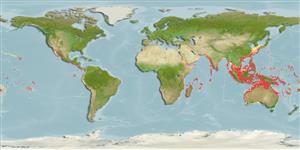Common names from other countries
Environment: milieu / climate zone / depth range / distribution range
Sinh thái học
Cùng sống ở rạn san hô; Mức độ sâu 0 - 100 m (Ref. 99185). Tropical
Indo-West Pacific.
Length at first maturity / Bộ gần gũi / Khối lượng (Trọng lượng) / Age
Maturity: Lm ? range ? - ? cm Max length : 17.0 cm TL con đực/không giới tính; (Ref. 92)
One of the most brightly colored stomatopods; with deep blue uropods; those and other appendages lined with bright red setae (Ref 92).
Life cycle and mating behavior
Chín muồi sinh dục | Sự tái sinh sản | Đẻ trứng | Các trứng | Sự sinh sản | Ấu trùng
Some members of the order Stomatopoda pair for life and some come together only to mate. Males produce sperm ducts rather than spermatophores; females can brood a maximum of 50,000 eggs. Life cycle: Eggs hatch to a planktonic zoea which lasts for 3 months.
Manning, R.B. 1998. (Ref. 92)
IUCN Red List Status (Ref. 130435: Version 2024-1)
CITES status (Ref. 108899)
Not Evaluated
Not Evaluated
Threat to humans
Harmless
Human uses
Bể nuôi cá: Tính thương mại
| FishSource |
Các công cụ
Thêm thông tin
Age/SizeSự sinh trưởngLength-weightLength-lengthHình thái họcẤu trùngSự phong phú
Các nguồn internet
Estimates based on models
Preferred temperature
(Ref.
115969): 24.3 - 29, mean 28 (based on 1610 cells).
Vulnerability
Low vulnerability (10 of 100).
Price category
Unknown.
